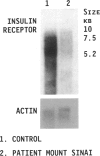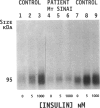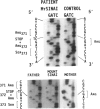Abstract
Leprechaunism is an autosomal recessive syndrome of severe insulin resistance and is characterized by intrauterine growth restriction, acanthosis nigricans, hirsutism, and loss of glucose homeostasis. Here we report a new female patient of Hispanic and Afro-American descent whose fibroblasts and lymphoblasts had markedly impaired insulin binding (less than 10% of that in controls). Insulin binding to lymphoblasts established from both unrelated parents was partially impaired. Insulin-like growth factor-I (IGF-I) and epidermal growth factor (EGF) binding to the patient's fibroblasts were within the normal range. Insulin stimulation of receptor autophosphorylation and kinase activity was markedly reduced in the patient's fibroblasts. The patient's fibroblasts had both a reduced number of immunoreactive insulin receptor (6% of those in controls) and concomitantly reduced amounts of insulin-receptor mRNA, suggesting that both mutations inherited by the patient reduced insulin-receptor mRNA. Sequencing of the insulin-receptor gene and cDNA indicated that the patient was heterozygous for a paternally derived mutation at bp 1333, converting Arg372 to a STOP codon. This nonsense mutation was observed in the insulin-receptor gene, but not in cDNA, indicating reduced amounts of mRNA for the allele containing this mutation. The coding sequence of the maternally inherited insulin-receptor allele was normal. Both the marked reduction in insulin-receptor mRNA in the compound heterozygous fibroblasts of the proband and the partially reduced insulin binding in maternal cells suggest that the maternally derived mutation is located in an insulin-receptor gene sequence that controls cellular mRNA content.
Full text
PDF
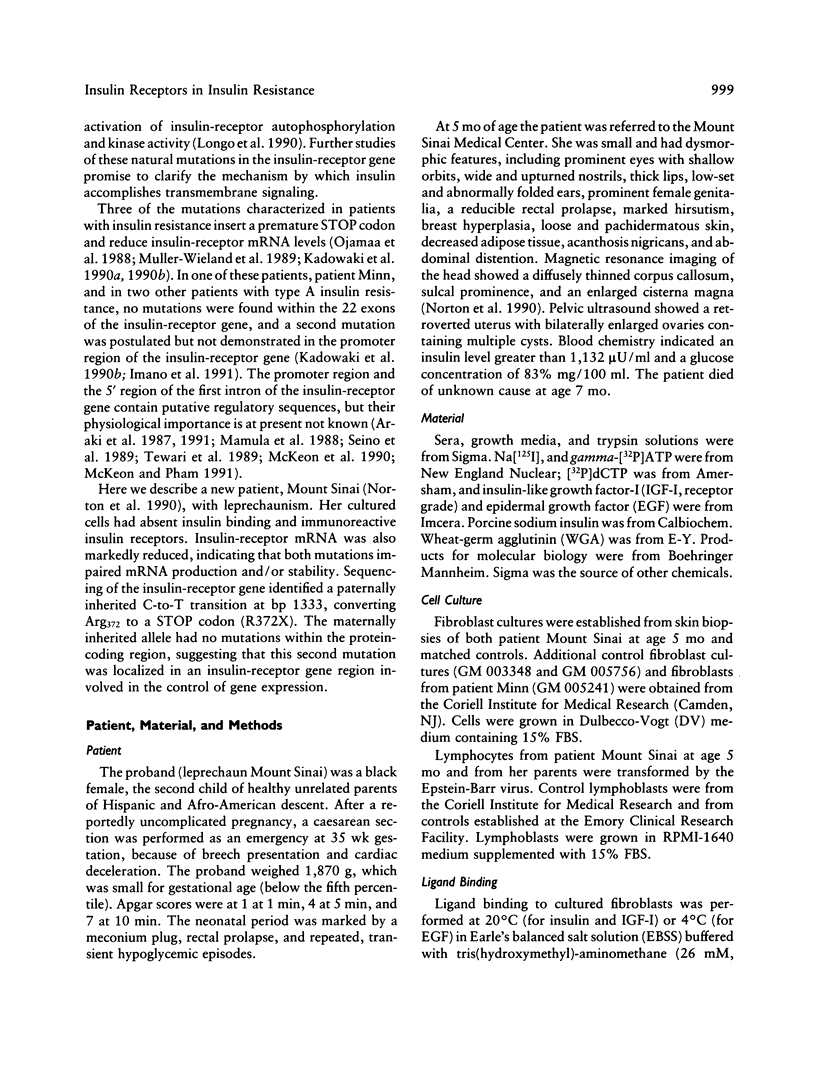

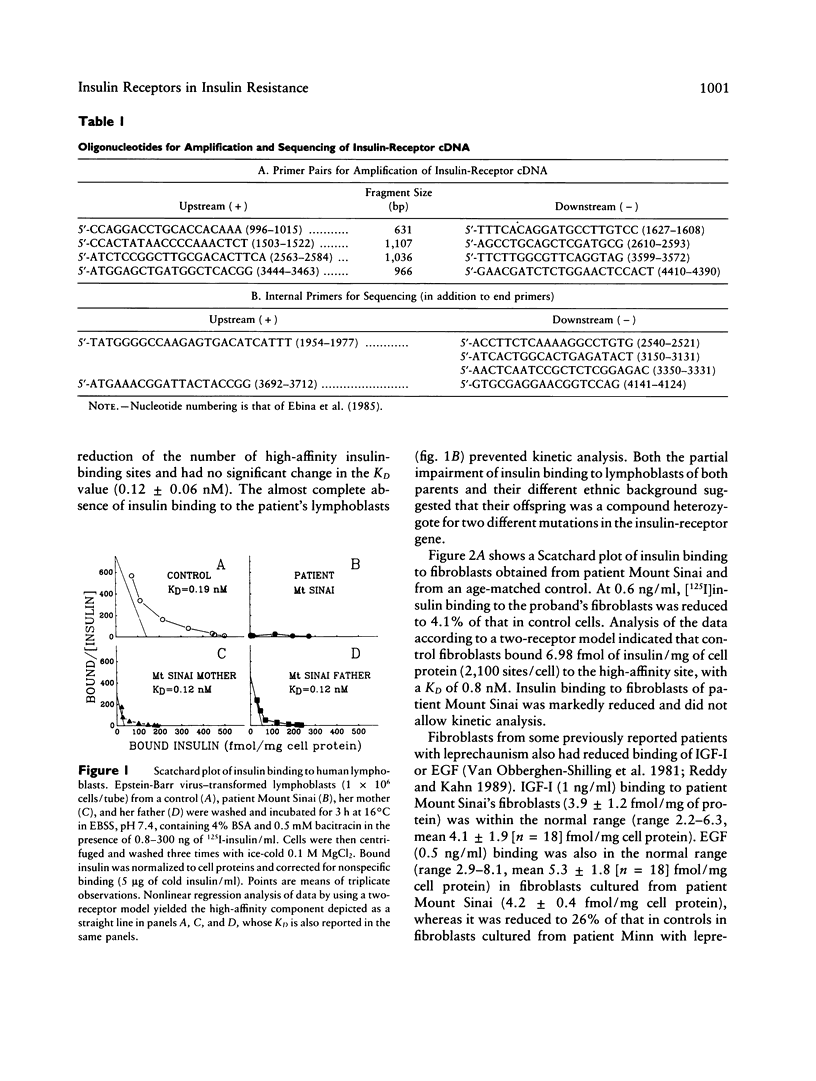
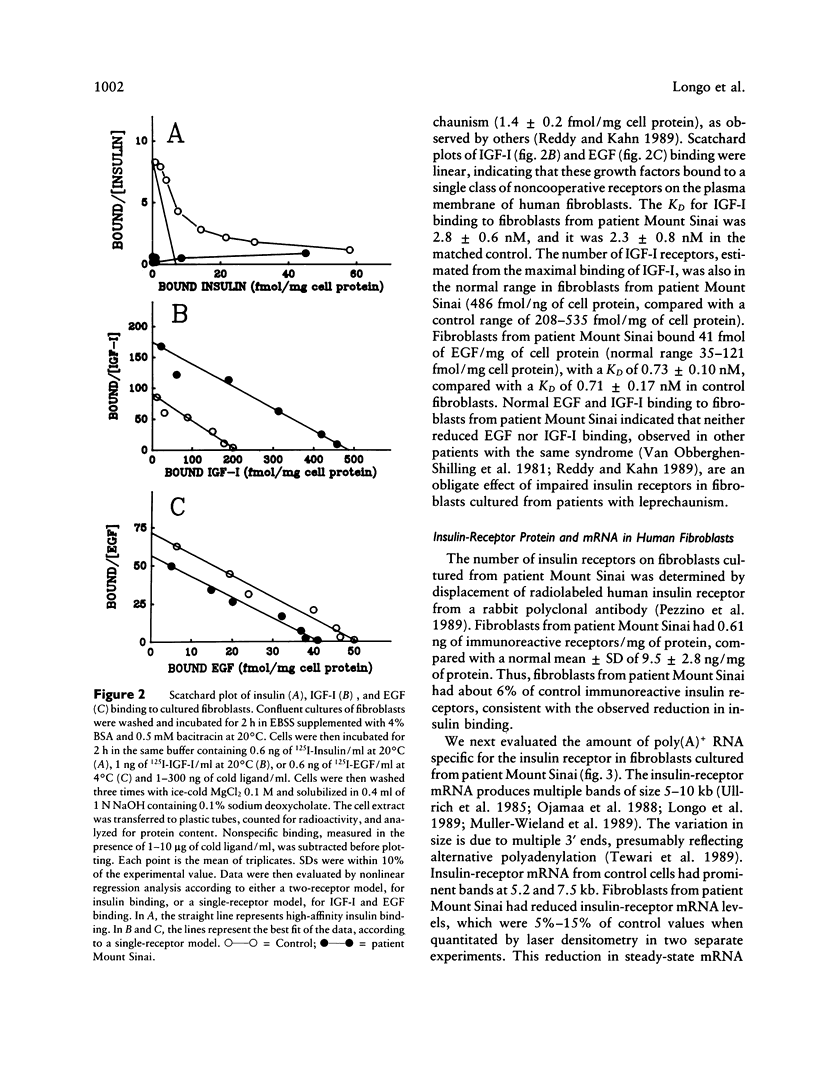
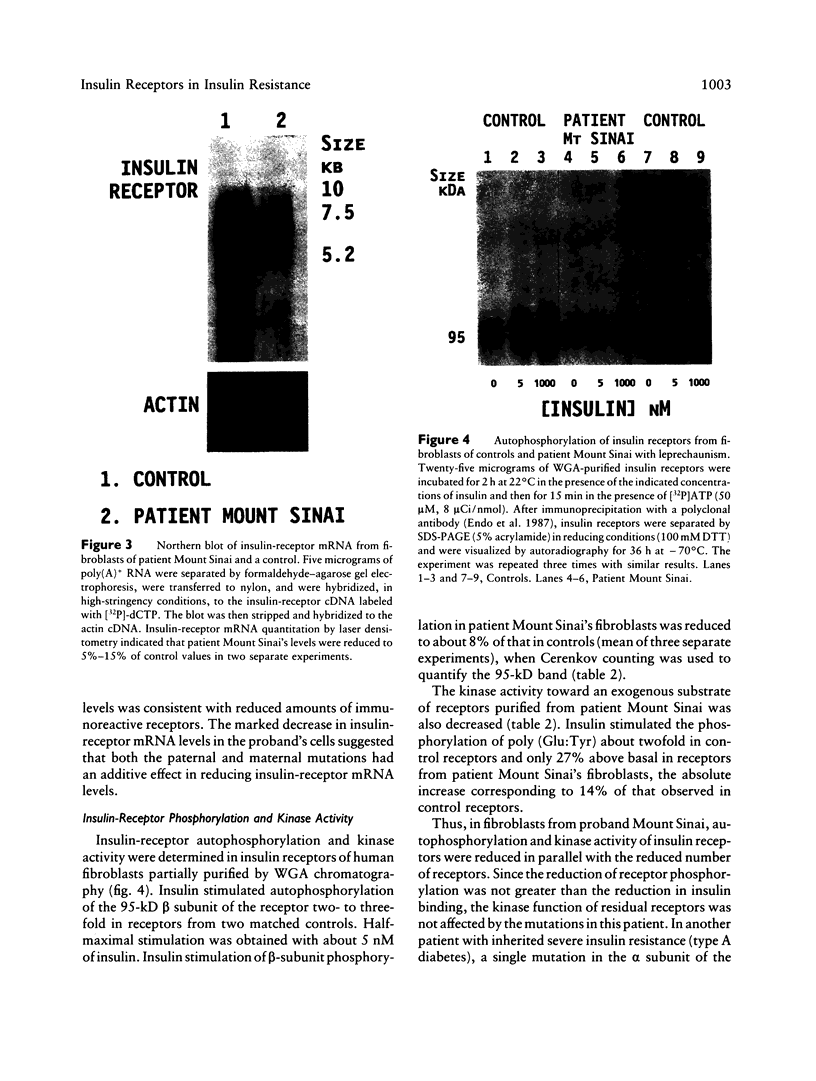
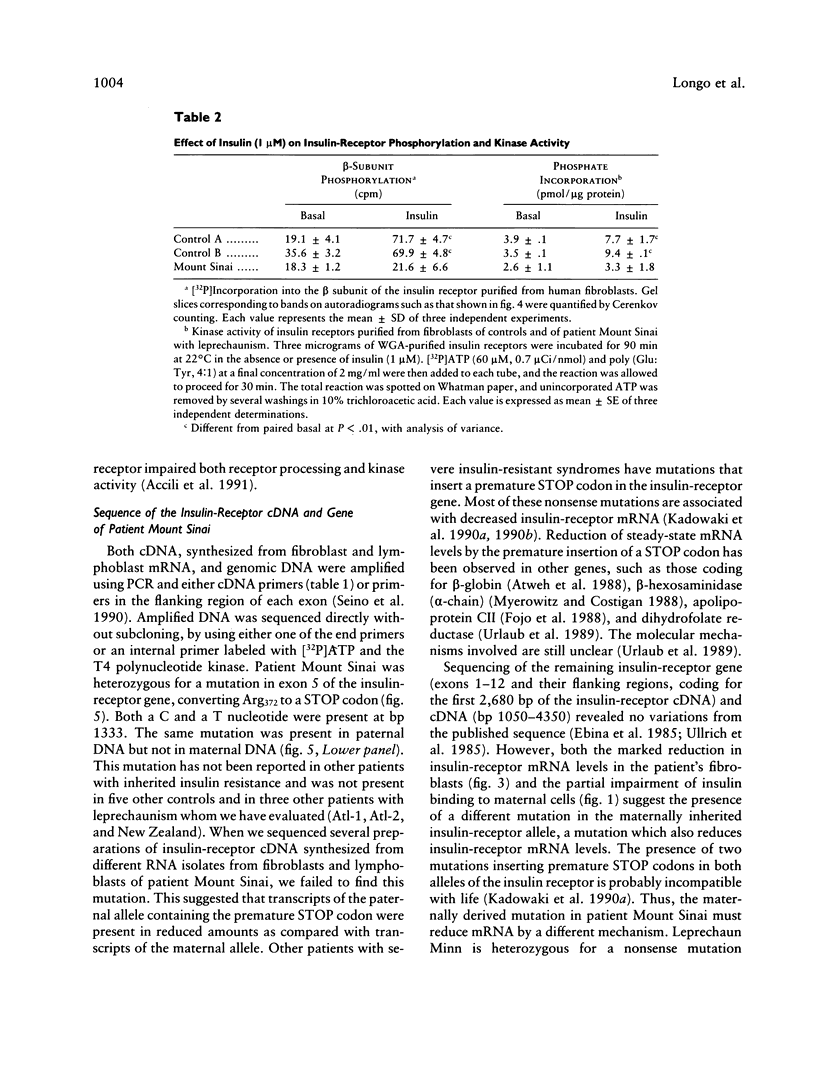
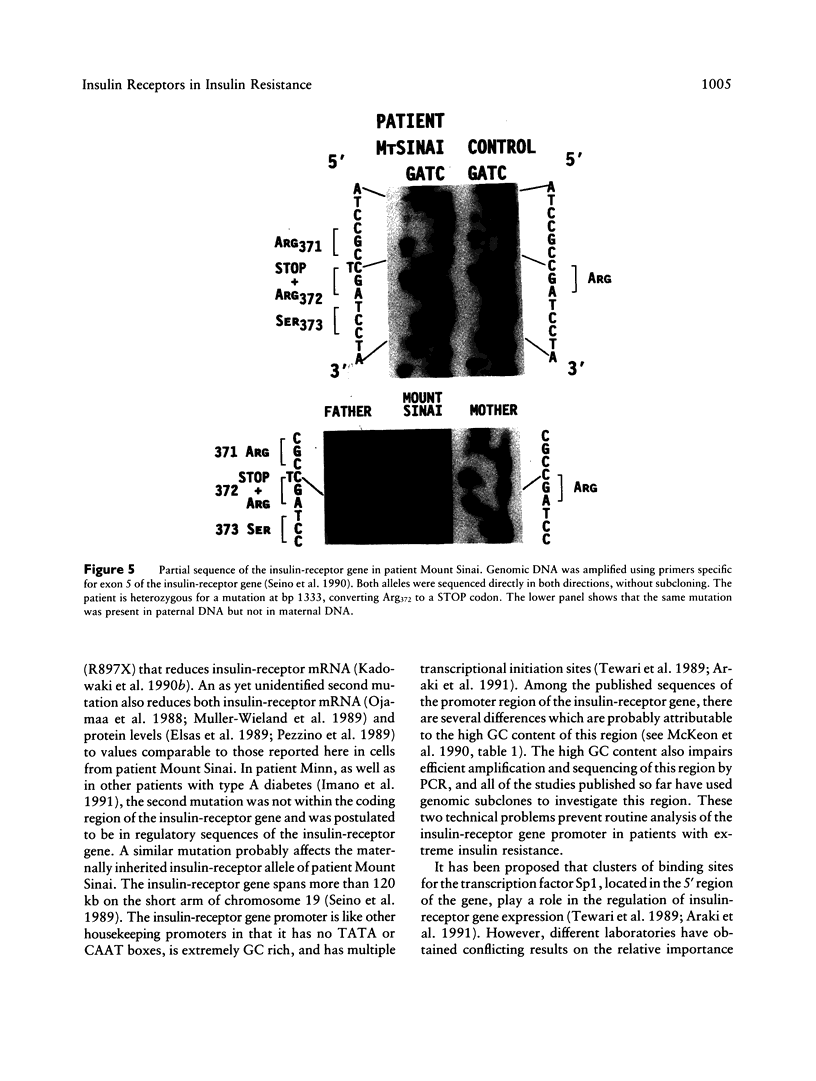
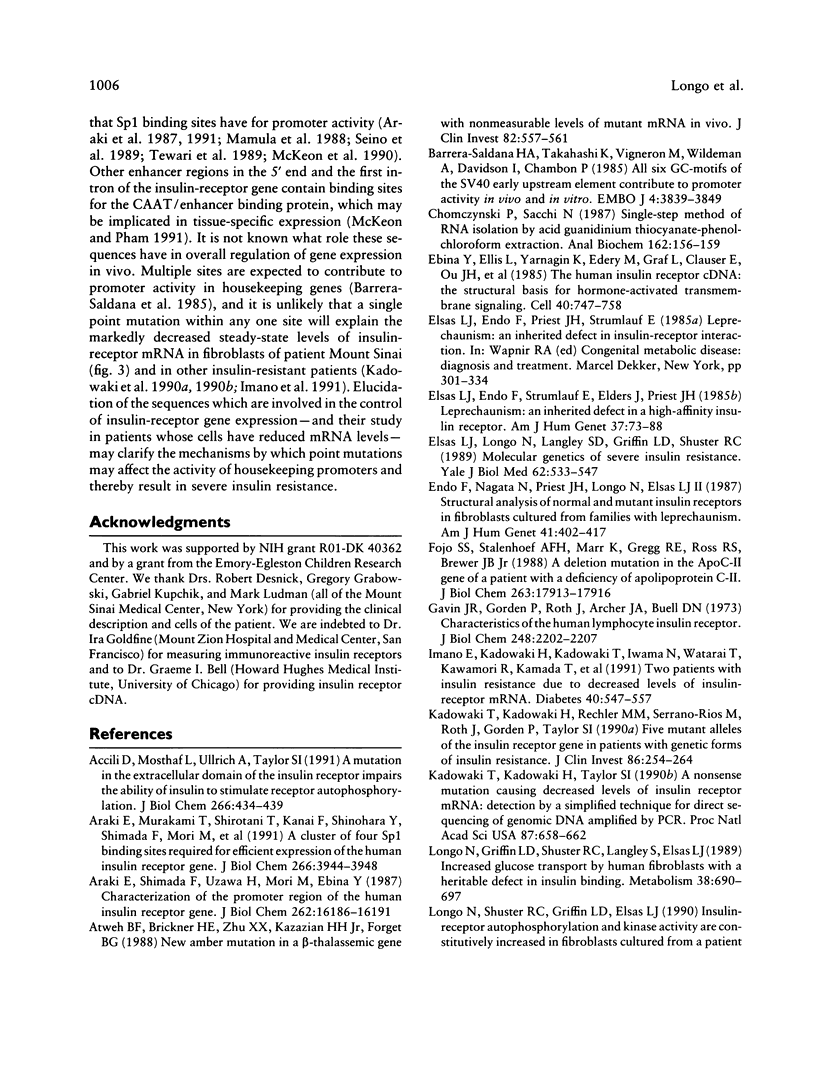
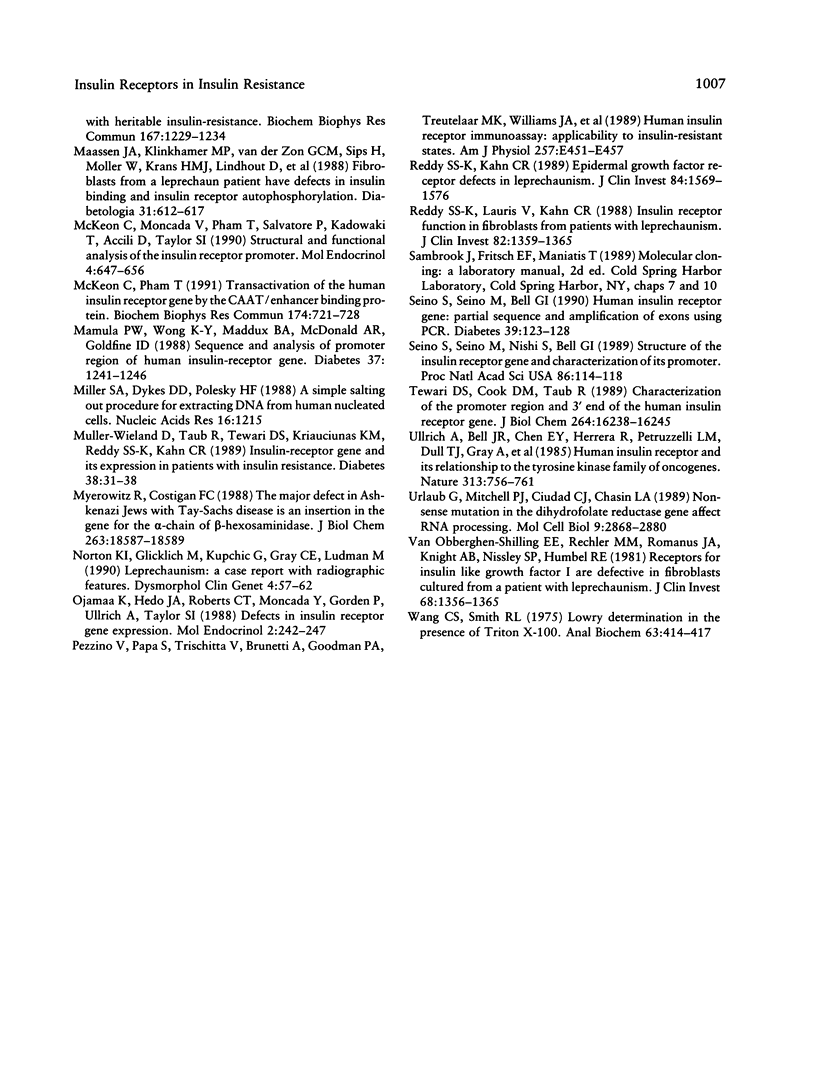
Images in this article
Selected References
These references are in PubMed. This may not be the complete list of references from this article.
- Accili D., Mosthaf L., Ullrich A., Taylor S. I. A mutation in the extracellular domain of the insulin receptor impairs the ability of insulin to stimulate receptor autophosphorylation. J Biol Chem. 1991 Jan 5;266(1):434–439. [PubMed] [Google Scholar]
- Araki E., Murakami T., Shirotani T., Kanai F., Shinohara Y., Shimada F., Mori M., Shichiri M., Ebina Y. A cluster of four Sp1 binding sites required for efficient expression of the human insulin receptor gene. J Biol Chem. 1991 Feb 25;266(6):3944–3948. [PubMed] [Google Scholar]
- Araki E., Shimada F., Uzawa H., Mori M., Ebina Y. Characterization of the promoter region of the human insulin receptor gene. Evidence for promoter activity. J Biol Chem. 1987 Nov 25;262(33):16186–16191. [PubMed] [Google Scholar]
- Atweh G. F., Brickner H. E., Zhu X. X., Kazazian H. H., Jr, Forget B. G. New amber mutation in a beta-thalassemic gene with nonmeasurable levels of mutant messenger RNA in vivo. J Clin Invest. 1988 Aug;82(2):557–561. doi: 10.1172/JCI113632. [DOI] [PMC free article] [PubMed] [Google Scholar]
- Barrera-Saldana H., Takahashi K., Vigneron M., Wildeman A., Davidson I., Chambon P. All six GC-motifs of the SV40 early upstream element contribute to promoter activity in vivo and in vitro. EMBO J. 1985 Dec 30;4(13B):3839–3849. doi: 10.1002/j.1460-2075.1985.tb04156.x. [DOI] [PMC free article] [PubMed] [Google Scholar]
- Chomczynski P., Sacchi N. Single-step method of RNA isolation by acid guanidinium thiocyanate-phenol-chloroform extraction. Anal Biochem. 1987 Apr;162(1):156–159. doi: 10.1006/abio.1987.9999. [DOI] [PubMed] [Google Scholar]
- Ebina Y., Ellis L., Jarnagin K., Edery M., Graf L., Clauser E., Ou J. H., Masiarz F., Kan Y. W., Goldfine I. D. The human insulin receptor cDNA: the structural basis for hormone-activated transmembrane signalling. Cell. 1985 Apr;40(4):747–758. doi: 10.1016/0092-8674(85)90334-4. [DOI] [PubMed] [Google Scholar]
- Elsas L. J., 2nd, Longo N., Langley S., Griffin L. D., Shuster R. C. Molecular genetics of severe insulin resistance. Yale J Biol Med. 1989 Sep-Oct;62(5):533–547. [PMC free article] [PubMed] [Google Scholar]
- Elsas L. J., Endo F., Strumlauf E., Elders J., Priest J. H. Leprechaunism: an inherited defect in a high-affinity insulin receptor. Am J Hum Genet. 1985 Jan;37(1):73–88. [PMC free article] [PubMed] [Google Scholar]
- Endo F., Nagata N., Priest J. H., Longo N., Elsas L. J., 2nd Structural analysis of normal and mutant insulin receptors in fibroblasts cultured from families with leprechaunism. Am J Hum Genet. 1987 Sep;41(3):402–417. [PMC free article] [PubMed] [Google Scholar]
- Fojo S. S., Stalenhoef A. F., Marr K., Gregg R. E., Ross R. S., Brewer H. B., Jr A deletion mutation in the ApoC-II gene (ApoC-II Nijmegen) of a patient with a deficiency of apolipoprotein C-II. J Biol Chem. 1988 Dec 5;263(34):17913–17916. [PubMed] [Google Scholar]
- Gavin J. R., 3rd, Gorden P., Roth J., Archer J. A., Buell D. N. Characteristics of the human lymphocyte insulin receptor. J Biol Chem. 1973 Mar 25;248(6):2202–2207. [PubMed] [Google Scholar]
- Imano E., Kadowaki H., Kadowaki T., Iwama N., Watarai T., Kawamori R., Kamada T., Taylor S. I. Two patients with insulin resistance due to decreased levels of insulin-receptor mRNA. Diabetes. 1991 May;40(5):548–557. doi: 10.2337/diab.40.5.548. [DOI] [PubMed] [Google Scholar]
- Kadowaki T., Kadowaki H., Rechler M. M., Serrano-Rios M., Roth J., Gorden P., Taylor S. I. Five mutant alleles of the insulin receptor gene in patients with genetic forms of insulin resistance. J Clin Invest. 1990 Jul;86(1):254–264. doi: 10.1172/JCI114693. [DOI] [PMC free article] [PubMed] [Google Scholar]
- Kadowaki T., Kadowaki H., Taylor S. I. A nonsense mutation causing decreased levels of insulin receptor mRNA: detection by a simplified technique for direct sequencing of genomic DNA amplified by the polymerase chain reaction. Proc Natl Acad Sci U S A. 1990 Jan;87(2):658–662. doi: 10.1073/pnas.87.2.658. [DOI] [PMC free article] [PubMed] [Google Scholar]
- Longo N., Griffin L. D., Shuster R. C., Langley S., Elsas L. J. Increased glucose transport by human fibroblasts with a heritable defect in insulin binding. Metabolism. 1989 Jul;38(7):690–697. doi: 10.1016/0026-0495(89)90109-1. [DOI] [PubMed] [Google Scholar]
- Longo N., Shuster R. C., Griffin L. D., Elsas L. J. Insulin-receptor autophosphorylation and kinase activity are constitutively increased in fibroblasts cultured from a patient with heritable insulin-resistance. Biochem Biophys Res Commun. 1990 Mar 30;167(3):1229–1234. doi: 10.1016/0006-291x(90)90655-7. [DOI] [PubMed] [Google Scholar]
- Maassen J. A., Klinkhamer M. P., van der Zon G. C., Sips H., Möller W., Krans H. M., Lindhout D., Beemer F. A. Fibroblasts from a leprechaun patient have defects in insulin binding and insulin receptor autophosphorylation. Diabetologia. 1988 Aug;31(8):612–617. doi: 10.1007/BF00264769. [DOI] [PubMed] [Google Scholar]
- Mamula P. W., Wong K. Y., Maddux B. A., McDonald A. R., Goldfine I. D. Sequence and analysis of promoter region of human insulin-receptor gene. Diabetes. 1988 Sep;37(9):1241–1246. doi: 10.2337/diab.37.9.1241. [DOI] [PubMed] [Google Scholar]
- McKeon C., Moncada V., Pham T., Salvatore P., Kadowaki T., Accili D., Taylor S. I. Structural and functional analysis of the insulin receptor promoter. Mol Endocrinol. 1990 Apr;4(4):647–656. doi: 10.1210/mend-4-4-647. [DOI] [PubMed] [Google Scholar]
- McKeon C., Pham T. Transactivation of the human insulin receptor gene by the CAAT/enhancer binding protein. Biochem Biophys Res Commun. 1991 Jan 31;174(2):721–728. doi: 10.1016/0006-291x(91)91477-t. [DOI] [PubMed] [Google Scholar]
- Miller S. A., Dykes D. D., Polesky H. F. A simple salting out procedure for extracting DNA from human nucleated cells. Nucleic Acids Res. 1988 Feb 11;16(3):1215–1215. doi: 10.1093/nar/16.3.1215. [DOI] [PMC free article] [PubMed] [Google Scholar]
- Muller-Wieland D., Taub R., Tewari D. S., Kriauciunas K. M., Sethu S., Reddy K., Kahn C. R. Insulin-receptor gene and its expression in patients with insulin resistance. Diabetes. 1989 Jan;38(1):31–38. doi: 10.2337/diab.38.1.31. [DOI] [PubMed] [Google Scholar]
- Myerowitz R., Costigan F. C. The major defect in Ashkenazi Jews with Tay-Sachs disease is an insertion in the gene for the alpha-chain of beta-hexosaminidase. J Biol Chem. 1988 Dec 15;263(35):18587–18589. [PubMed] [Google Scholar]
- Ojamaa K., Hedo J. A., Roberts C. T., Jr, Moncada V. Y., Gorden P., Ullrich A., Taylor S. I. Defects in human insulin receptor gene expression. Mol Endocrinol. 1988 Mar;2(3):242–247. doi: 10.1210/mend-2-3-242. [DOI] [PubMed] [Google Scholar]
- Pezzino V., Papa V., Trischitta V., Brunetti A., Goodman P. A., Treutelaar M. K., Williams J. A., Maddux B. A., Vigneri R., Goldfine I. D. Human insulin receptor radioimmunoassay: applicability to insulin-resistant states. Am J Physiol. 1989 Sep;257(3 Pt 1):E451–E457. doi: 10.1152/ajpendo.1989.257.3.E451. [DOI] [PubMed] [Google Scholar]
- Reddy S. S., Kahn C. R. Epidermal growth factor receptor defects in leprechaunism. A multiple growth factor-resistant syndrome. J Clin Invest. 1989 Nov;84(5):1569–1576. doi: 10.1172/JCI114334. [DOI] [PMC free article] [PubMed] [Google Scholar]
- Reddy S. S., Lauris V., Kahn C. R. Insulin receptor function in fibroblasts from patients with leprechaunism. Differential alterations in binding, autophosphorylation, kinase activity, and receptor-mediated internalization. J Clin Invest. 1988 Oct;82(4):1359–1365. doi: 10.1172/JCI113739. [DOI] [PMC free article] [PubMed] [Google Scholar]
- Seino S., Seino M., Bell G. I. Human insulin-receptor gene. Partial sequence and amplification of exons by polymerase chain reaction. Diabetes. 1990 Jan;39(1):123–128. doi: 10.2337/diacare.39.1.123. [DOI] [PubMed] [Google Scholar]
- Seino S., Seino M., Nishi S., Bell G. I. Structure of the human insulin receptor gene and characterization of its promoter. Proc Natl Acad Sci U S A. 1989 Jan;86(1):114–118. doi: 10.1073/pnas.86.1.114. [DOI] [PMC free article] [PubMed] [Google Scholar]
- Tewari D. S., Cook D. M., Taub R. Characterization of the promoter region and 3' end of the human insulin receptor gene. J Biol Chem. 1989 Sep 25;264(27):16238–16245. [PubMed] [Google Scholar]
- Ullrich A., Bell J. R., Chen E. Y., Herrera R., Petruzzelli L. M., Dull T. J., Gray A., Coussens L., Liao Y. C., Tsubokawa M. Human insulin receptor and its relationship to the tyrosine kinase family of oncogenes. 1985 Feb 28-Mar 6Nature. 313(6005):756–761. doi: 10.1038/313756a0. [DOI] [PubMed] [Google Scholar]
- Urlaub G., Mitchell P. J., Ciudad C. J., Chasin L. A. Nonsense mutations in the dihydrofolate reductase gene affect RNA processing. Mol Cell Biol. 1989 Jul;9(7):2868–2880. doi: 10.1128/mcb.9.7.2868. [DOI] [PMC free article] [PubMed] [Google Scholar]
- Van Obberghen-Schilling E. E., Rechler M. M., Romanus J. A., Knight A. B., Nissley S. P., Humbel R. E. Receptors for insulinlike growth factor I are defective in fibroblasts cultured from a patient with leprechaunism. J Clin Invest. 1981 Nov;68(5):1356–1365. doi: 10.1172/JCI110383. [DOI] [PMC free article] [PubMed] [Google Scholar]
- Wang C., Smith R. L. Lowry determination of protein in the presence of Triton X-100. Anal Biochem. 1975 Feb;63(2):414–417. doi: 10.1016/0003-2697(75)90363-2. [DOI] [PubMed] [Google Scholar]



